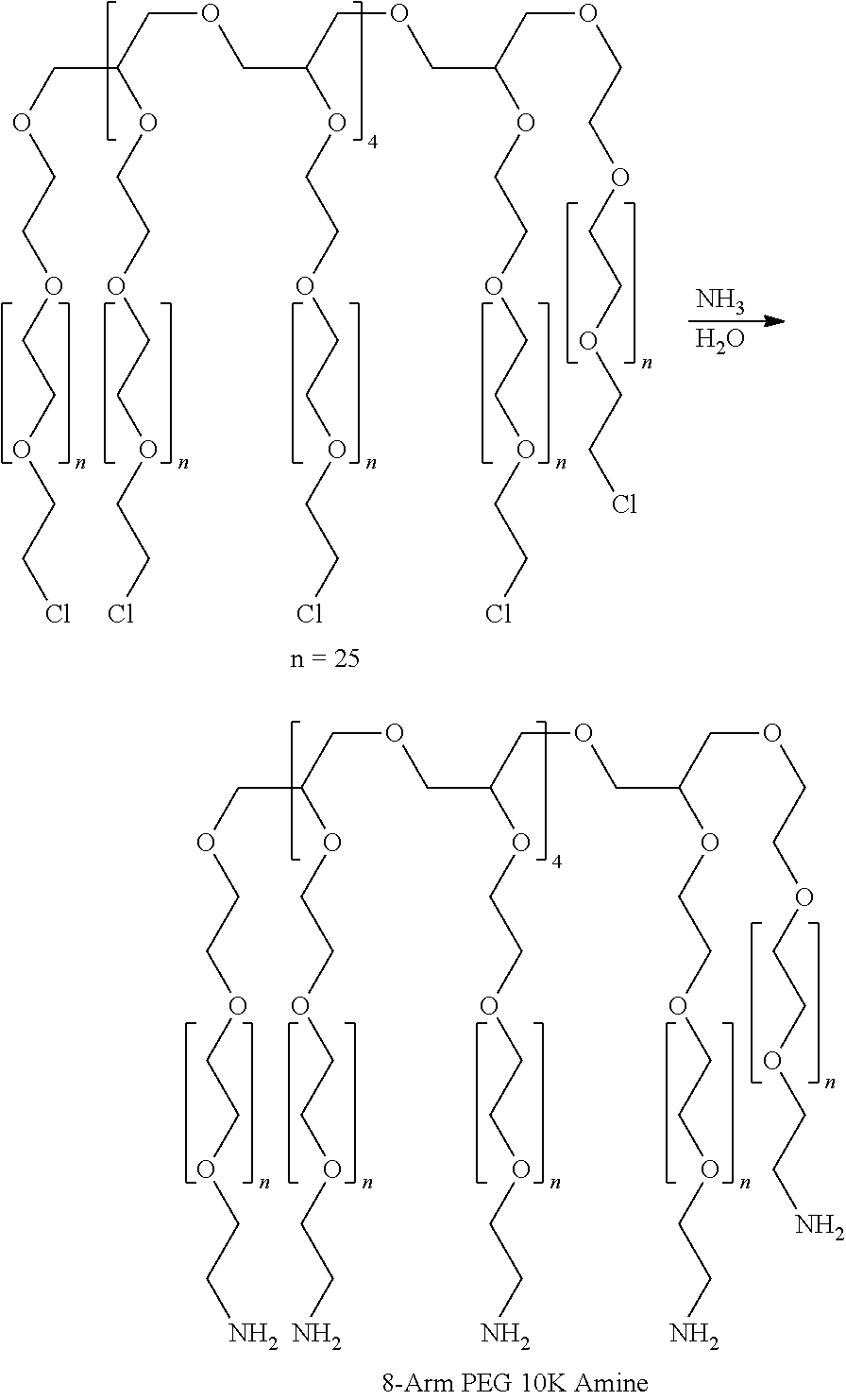Low swell, long-lived hydrogel sealant
a hydrogel and long-lasting technology, applied in the field of medical adhesives, can solve the problems of slow curing of fibrin-based adhesives, limited internal application and inconvenient use of conventional tissue adhesives
- Summary
- Abstract
- Description
- Claims
- Application Information
AI Technical Summary
Benefits of technology
Problems solved by technology
Method used
Image
Examples
examples
[0105]The present invention is further defined in the following Examples. It should be understood that these Examples, while indicating preferred embodiments of the invention, are given by way of illustration only. From the above discussion and these Examples, one skilled in the art can ascertain the essential characteristics of this invention, and without departing from the spirit and scope thereof, can make various changes and modifications of the invention to adapt it to various uses and conditions.
[0106]The meaning of abbreviations used is as follows: “min” means minute(s), “h” means hour(s), “sec” means second(s), “d” means day(s), “mL” means milliliter(s), “L” means liter(s), “μL” means microliter(s), “cm” means centimeter(s), “mm” means millimeter(s), “μm” means micrometer(s), “mol” means mole(s), “mmol” means millimole(s), “g” means gram(s), “mg” means milligram(s), “kg” means kilogram(s), “wt %” means percent by weight, “mol %” means mole percent, “M” means molar concentrat...
examples 1-10
In Vitro Degradation of Hydrogels—Comparison at the Same Solids Content
[0123]The purpose of these Examples was to demonstrate that the hydrogels formed by reaction of a highly oxidized dextran aldehyde with a multi-arm PEG amine degrade in vitro much more slowly than a hydrogel formed from a less oxidized dextran aldehyde and a multi-arm PEG amine, at the same solids content.
[0124]The hydrogel samples were prepared by mixing equal volumes of an aqueous solution of a dextran aldehyde and an aqueous solution of a multi-arm PEG amine, as shown in Table 1. After the hydrogels cured, the samples were weighed and placed inside jars containing PBS (phosphate buffered saline) at pH 7.4. The jars were placed inside a temperature-controlled shaker set at 80 rpm and 37° C. The samples were removed from the jars at various times, blotted to remove excess solution, and weighed. Then, the samples were returned to the jars.
[0125]The results are summarized in Table 1. The degradation day is defined...
examples 11 and 12
In Vitro Biocompatibility Testing—Cytotoxicity
[0127]The purpose of these Examples was to demonstrate the safety of hydrogels resulting from the reaction of a multi-arm PEG amine with a highly oxidized dextran aldehyde in an in vitro test.
[0128]The testing was done using NIH3T3 mouse fibroblast cell cultures according to ISO10993-5:1999. The NIH3T3 mouse fibroblast cells were obtained from the American Type Culture Collection (ATCC; Manassas, Va.) and were grown in Dulbecco's modified essential medium (DMEM), supplemented with 10% fetal calf serum.
[0129]NIH3T3 mouse fibroblast cell cultures were challenged with hydrogels made by combining equal volumes of an aqueous solution of a highly oxidized-dextran aldehyde and an aqueous solution of a multi-arm PEG amine, as shown in Table 2. Each hydrogel was placed in a well in a polystyrene culture plate such that about ¼ of the well bottoms were covered. The wells were then sterilized under UV light and seeded with 50,000-100,000 NIH3T3 cel...
PUM
| Property | Measurement | Unit |
|---|---|---|
| equivalent weight | aaaaa | aaaaa |
| weight-average molecular weight | aaaaa | aaaaa |
| number-average molecular weight | aaaaa | aaaaa |
Abstract
Description
Claims
Application Information
 Login to View More
Login to View More - R&D
- Intellectual Property
- Life Sciences
- Materials
- Tech Scout
- Unparalleled Data Quality
- Higher Quality Content
- 60% Fewer Hallucinations
Browse by: Latest US Patents, China's latest patents, Technical Efficacy Thesaurus, Application Domain, Technology Topic, Popular Technical Reports.
© 2025 PatSnap. All rights reserved.Legal|Privacy policy|Modern Slavery Act Transparency Statement|Sitemap|About US| Contact US: help@patsnap.com


